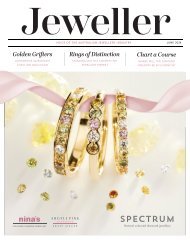Jeweller - May 2021
Create successful ePaper yourself
Turn your PDF publications into a flip-book with our unique Google optimized e-Paper software.
OPINION<br />
Soapbox<br />
Dispelling the myths and misconceptions<br />
about jewellery valuations<br />
RIKKI MCANDREW explores how jewellery valuations have evolved over time and<br />
what jewellers and consumers can expect from a modern valuation.<br />
As with most industries, jewellery<br />
valuation has been affected by the<br />
advances in technology in recent years<br />
and valuers have had to learn a host of new<br />
skills – to the benefit of jewellers and their<br />
customers alike.<br />
In days now long gone, producing valuations<br />
was a very different proposition. We didn’t<br />
have access to the technology we do today<br />
– including computers and digital cameras –<br />
so many older valuations are simply written<br />
documents without images.<br />
What’s more, the descriptions in these older<br />
valuations often lack detail, leaving too much<br />
room for misinterpretation and guesswork.<br />
The terminology used could be quite<br />
confusing to the layman, if not the trade;<br />
an old valuation might include a diamond<br />
colour described as ‘Jager’, ‘river’, ‘(top)<br />
Wesselton’ or ‘(top) cape’, rather than the<br />
alphabetical system in use today.<br />
However, since the foundation of the<br />
National Council of <strong>Jeweller</strong>y Valuers<br />
(NCJV), a system of standardisation is in<br />
place and continuously being improved.<br />
All jewellery valuations today must have a<br />
photograph and a full description, including<br />
weights and measurements – which are also<br />
frequently missing from old valuations!<br />
In terms of implementing these standards,<br />
the NCJV was the first jewellery valuer<br />
organisation in the world to develop its own<br />
accredited valuer course.<br />
Valuations are a critical source of<br />
information when it comes to identifying<br />
lost and stolen jewellery, especially<br />
when there is a dispute of provenance or<br />
ownership, or a police investigation.<br />
It is hard to argue against anything unique to<br />
an item such as a hallmark, an engraving,<br />
a chip, or anything else that the valuer<br />
observes and notes in the valuation.<br />
Of course, while valuations have come a long<br />
way, there are still limitations; for example,<br />
a set diamond can’t be graded higher than<br />
a G colour, therefore it may be necessary to<br />
remove the diamond for a more accurate<br />
grading as this could significantly impact the<br />
value of the overall piece.<br />
For this reason, it is necessary to educate<br />
consumers on this point and advocate for it<br />
to be done routinely.<br />
As retailers are often the ‘middleman’<br />
between consumers and valuers, the trade<br />
should also take these factors into account<br />
when advising their customers.<br />
There are a few other misconceptions that<br />
aren’t immediately obvious, but should be.<br />
Firstly, a valuer can’t simply look at a piece<br />
of jewellery and give a dollar value – nor can<br />
a professional valuation determine a piece’s<br />
previous retail value or its guaranteed<br />
second-hand/resale value.<br />
Valuations act as a reliable source of<br />
information which can then be interpreted<br />
as the basis for determining a second-hand<br />
value. Put simply, a seller must know and<br />
understand the market for the piece; the<br />
valuation simply tells them exactly what it is<br />
they are selling!<br />
A retail price can then be developed that<br />
includes a standard mark-up – something<br />
that is not taken into account in a valuation.<br />
Valuations of the same piece by different<br />
valuers almost certainly won’t have the<br />
same dollar value.<br />
Another important point is that valuers<br />
rarely have an advertised price list. One of<br />
the main reasons for this is variation – each<br />
valuation is unique, and while an average<br />
All jewellery<br />
valuations<br />
today must have<br />
a photograph<br />
and a full<br />
description,<br />
including<br />
weights and<br />
measurements<br />
– which are<br />
also frequently<br />
missing from<br />
old valuations!<br />
valuation takes one hour to complete, some<br />
can take eight hours or more!<br />
For more complex valuations, a piece of<br />
jewellery may also need to be shown to<br />
other valuers, wholesalers or antiques<br />
dealers for a second opinion.<br />
As a result, the NCJV does not monitor<br />
prices nor recommend a price range to its<br />
registered valuers.<br />
Still, it’s a question often asked, by jewellers<br />
and consumers alike: how much should a<br />
valuation cost? It’s similar to asking, how<br />
long is a piece of string?<br />
When developing their price structure,<br />
valuers will take into account the cost<br />
of purchasing and maintaining their<br />
gemmological equipment, indemnity<br />
insurance, continuing professional<br />
development, subscriptions to price<br />
guides and sales realisations, and NCJV<br />
membership fees.<br />
NCJV-registered valuers are professionally<br />
trained, and they deal in facts, not hopes<br />
or wishes. At the end of the day, the valuer<br />
signs a document which can be admitted to<br />
court; they can’t take into account what the<br />
client believes to be true, or what they were<br />
told when they bought a jewellery piece.<br />
There are still some in the jewellery<br />
industry who lack knowledge or experience<br />
with valuations, and this is where problems<br />
regularly arise. But there is no excuse<br />
for ignorance – and that’s what jewellery<br />
valuations are designed to prevent.<br />
Name: Rikki McAndrew FGAA Dip DT<br />
Company: McAndrew <strong>Jeweller</strong>y, and<br />
Australian <strong>Jeweller</strong>y Valuers<br />
Position: Director<br />
Location: Melbourne, VIC<br />
Years in Industry: 48<br />
57 | <strong>May</strong> <strong>2021</strong>


















